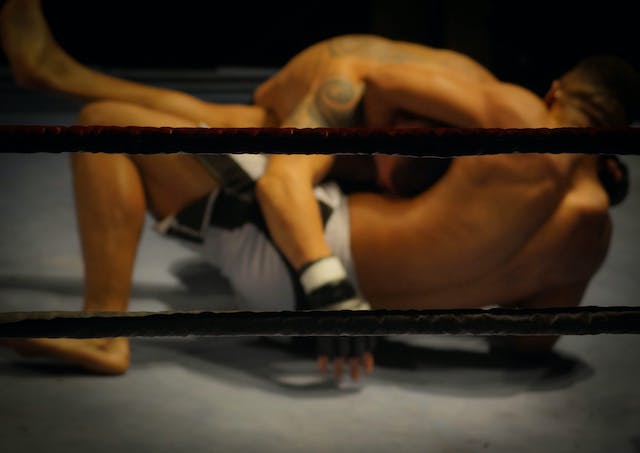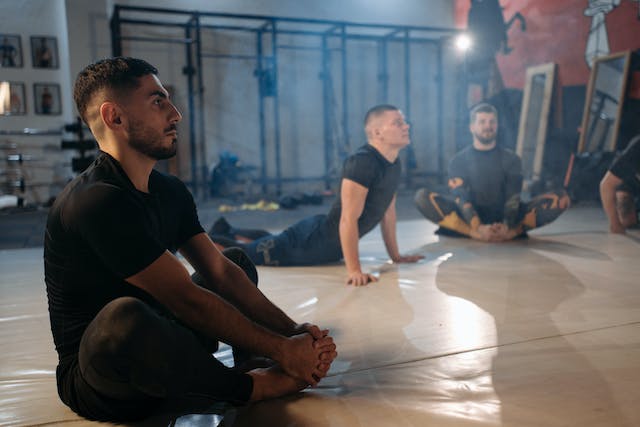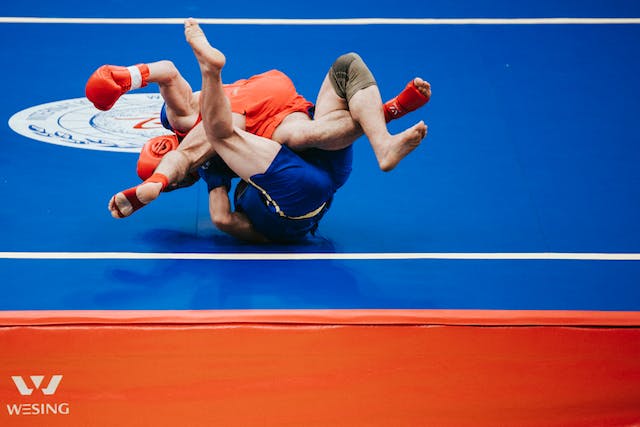Martial arts training
Developing both mental and physical skills is part of martial arts training, which involves studying various combat techniques. Each and every martial arts style and discipline has its own training schedule.
Martial arts training include not only striking, grappling, and joint locks, but also forms, exercises, and sparring. Conditioning exercises like running, jumping, and weight training are often used to improve overall fitness and endurance.

Martial arts also place a heavy emphasis on the development of mental and emotional skills, such as self-control, discipline, and respect. In order to develop the mind as well as the body, many martial arts schools also teach mindfulness and meditation practices.
Martial arts training may be beneficial for those who are interested in self-defense, physical fitness, or personal growth. It’s important to choose a reliable school or instructor and approach the learning process with an open mind.
There are many different elements to martial arts training, including unique styles, beliefs, and benefits. Here are some other things to consider:
Martial arts training helps kids become more focused, disciplined, physically strong, resilient to bullying, and capable of self-defense. Cross-Training: Practitioners may use a range of techniques to build all-encompassing skills. Philosophy and Spirituality: To increase practitioners’ levels of inner awareness and global perception, several approaches use mindfulness, meditation, and other practices. Weapons Training: Some styles include weapons training, such sword or stick fighting, to help students develop an awareness of focus, coordination, and cultural significance. Health Benefits: Martial arts training has potential mental, emotional, and self-confidence boosts in addition to its physical benefits.
Several popular martial arts include:
Karate is a Japanese martial art that emphasizes striking techniques heavily.
The Korean martial art of taekwondo places a strong emphasis on powerful punches and high kicks.
Japanese martial art judo emphasizes throwing and grappling techniques.
Brazilian Jiu-Jitsu is a martial art that originated in Brazil and places a strong emphasis on submission techniques and ground combat.
Punching, knee, elbow, and elbow assaults are heavily emphasized in the Thai martial art known as Muay Thai.
Chinese martial arts come in several forms, including Kung Fu.
Aikido, a Japanese martial art, emphasizes using the strength of an opponent against him.
Boxing: A striking and footwork-based fighting sport.
Israel invented the self-defense technique known as Krav Maga, which emphasizes practical application of abilities.
Among the most popular styles are Shotokan Karate, Hapkido, Capoeira, and Wing Chun. With so many options available, it’s critical to choose a teacher and teaching style that align with your goals and tastes.
The history of martial arts
The history of martial arts is complex and extensive, including several styles and techniques that have developed over millennia in diverse cultural and geographic contexts. There is evidence of hand-to-hand combat and martial arts training in many ancient civilizations, including Egypt, China, India, and Greece, even if it may be challenging to determine the exact origins of martial arts.
BC Chinese boxing, also known as kung fu, is one of the oldest known martial arts forms, dating back to 3000 BC. In ancient China, martial arts were practiced for self-defense, hunting, and military preparation. Over time, Kung Fu evolved into an intricate system of movements, positions, and concepts.

Martial arts developed in Japan among the samurai warrior class, who were trained in various fighting techniques for both self-defense and warfare. One of the most well-known and entertaining Japanese martial arts is karate, which originated in Okinawa in the 19th century and included elements of Chinese martial arts.
The unique martial art of taekwondo, which has its roots in Korea, emphasizes powerful punches and high kicks. Since its inclusion in the Olympic program in 2000, taekwondo has become more and more well-known worldwide.
Other martial arts, such as Silat in Indonesia and Malaysia and Muay Thai in Thailand, have gained popularity across Southeast Asia. These fighting styles, which use a variety of grappling techniques, are now popular combat sports across the world.
Martial arts gained popularity in the West throughout the 20th century, particularly when Bruce Lee became well-known and combined elements of many other martial arts to create the hybrid style Jeet Kune Do. Martial arts are expanding, evolving, and adding new forms and techniques to their repertoires these days.
Most popular martial arts worldwide
Numerous countries are renowned for their legacy in martial arts. Among the most well-known are these:
China: Martial arts have a long history there, and styles like Wing Chun, Tai Chi, and Kung Fu are becoming more well-known elsewhere.
Karate, Judo, and Aikido are among the martial arts that are most popular in Japan.
Korea: Taekwondo, one of the most well-known martial arts in the world, has its origins in Korea and is noted for its emphasis on powerful, fast punches and high kicks.
Thailand—Thai Boxing, or Muay Thai, is a popular martial art there that is recognized for its striking techniques, which include the use of fists, elbows, knees, and shins.
Brazil: Brazilian Jiu-Jitsu was developed there and is now practiced all over the world. It concentrates on ground fighting and submission techniques.
India: India has a long history of martial arts, and one of its most well-known styles is Kalaripayattu, which is praised worldwide for its emphasis on flexibility, balance, and synchronicity.
The martial art known as Pencak Silat originated in Indonesia and Malaysia. It is growing more and more popular all over the globe and is highly renowned for its close-quarters combat techniques.
There are other countries with notable martial arts histories, including the Philippines, Russia, Iran, and Thailand.
Numerous countries are the birthplace of some well-known martial arts. Some of them include:
- Muay Thai from Thailand
- Jitsu Braziliana is a fighting style.
- boxing is from the United Kingdom.
- Krav Maga, produced in Israel
- Chinese Taekwondo
- As judo in Japan
- Chinese Fried Chicken
- Brazilian drumming
- Japanese hapkido
- Karate from Japan
- Kendo in Japan
Every martial art has its unique origins, techniques, and philosophy. Even if some are more popular than others, all have contributed to the diverse martial arts landscape.
Training in martial arts may have a number of detrimental effects on a person’s physical, mental, and emotional health.
Here are a few common effects that are often observed:
Physical fitness: The physical training and conditioning involved in martial arts may improve a person’s cardiovascular health, strength, flexibility, and overall fitness.
Self-defense: The main focus of martial arts is on self-defense techniques, which may teach individuals the skills and knowledge to protect oneself in dangerous situations.
Relieving stress: People may find it easier to manage their tension and anxiety levels if they practice martial arts, which require discipline and attention.
Self-assurance: As martial arts students progress, they may feel more secure and in control of their training.
In martial arts, discipline and focus are crucial, and these traits may also be used in other areas of life, like work or school.
Socialization: Signing up for martial arts classes may allow you the opportunity to get to know other students and create a feeling of belonging.
Understanding culture: Because many martial arts have deep cultural roots, practitioners may learn to value and understand the customs and background associated with the style they are currently learning.
Generally speaking, martial arts may have varying effects on each person based on their goals and level of dedication. However, martial arts may have positive physical, mental, and emotional impacts that can enhance one’s overall wellbeing.
A variety of martial arts
The phrase “martial arts” encompasses a wide range of specializations, each with its own techniques, tenets, and cultural roots. The following are some of the most well-known martial arts forms:
Okinawa is the birthplace of karate, a Japanese martial art that emphasizes punches, kicks, and blocks.
Taekwondo, the renowned Korean martial art, has a strong emphasis on jumping, spinning, and high kicks.

Another Japanese martial art that stresses grappling, takedowns, and throws to subdue opponents is judo.
A ground-based martial art, Brazilian Jiu-Jitsu uses joint locks, grappling, and submission techniques to neutralize opponents.
Muay Thai is a kind of Thai fighting that places a strong emphasis on clinching, throwing, and using the fists, elbows, knees, and shins.
The Chinese martial art known as Kung Fu is made up of several styles and techniques, among which Wing Chun, Tai Chi, and Shaolin Kung Fu are just a few examples.
Israeli martial arts company Krav Maga emphasizes practical self-defense methods. It is a common practice among police enforcement and military personnel.
Using your opponent’s momentum and energy to your advantage is a key component in the Japanese martial art of aikido.
One Brazilian martial style is capoeira, which blends dance, music, and acrobatics with martial arts methods.
Korean martial arts known as hapkido involve joint locks, throws, and blows and emphasize circular movements and non-resistance.
Some notable martial arts include fencing from Europe, Silat from Southeast Asia, and Systema from Russia. Every one of these martial arts has unique characteristics, a unique history, and unique cultural significance.
Why it matters to wrestle with rumors
Wrestling rumors may be very important to fans and media sources that cover professional wrestling.
Fans might get excited and more interested in a wrestler when they hear rumors about upcoming matches, storylines, or debuts. More individuals may get interested in the product as a consequence, and more people may watch or attend wrestling matches.
Wrestling rumors may provide viewers with an inside look into the inner workings of the wrestling industry and throw light on the politics that go on behind the scenes. This might contain information about negotiations, creative decisions, and other aspects of the business that aren’t often disclosed to the public. By understanding these relationships, fans may enjoy the art form and better comprehend what they see on TV.
They could promote discussion and argument: Wrestling rumors often spark debate and discussion among supporters. Supporters may argue about the merits of a potential match, differ over the direction of a story, or assume that a wrestler’s actions are motivated by something. These discussions could improve ties amongst fans and deepen their dedication to the company.
Rumors about wrestling are funny in and of themselves, so they may be entertaining. It might be entertaining for fans to imagine their own ideal reservations or to guess what would occur next. Additionally, media outlets might cover rumors in a humorous or lighthearted way, providing fans with an enjoyable read or listen.
It’s important to remember that there are times when wrestling rumors aren’t reliable or accurate. They could be based on hearsay, speculation, or outright deception. Fans and the media should approach rumors with a healthy dose of skepticism and hold off on believing them until credible sources confirm them or the wrestling companies themselves make them public.
Rumors about wrestling will benefit their audience.
Rumors may be advantageous to wrestling fans in a few different ways.
They could provide details on the wrestling industry: Rumors about the industry might offer fans an insight into its inner workings. This might contain information about negotiations, creative decisions, and other aspects of the business that aren’t often disclosed to the public. By being aware of these interactions, fans may be able to enjoy the art form and better comprehend what they see on TV.
They could arouse curiosity and suspense since wrestling enthusiasts like making predictions about what might happen next. Wrestling-related rumors regarding upcoming matches, plots, and events may pique viewers’ curiosity and build anticipation. This might increase fans’ excitement and anticipation, which could increase interest in the product.
They may be entertaining: Wrestling rumors on their own could be intriguing. It might be entertaining for fans to imagine their own ideal reservations or to guess what would occur next. Additionally, media outlets might cover rumors in a humorous or lighthearted way, providing fans with an enjoyable read or listen.
They could promote discussion and argument: Wrestling rumors often spark debate and discussion among supporters. Supporters may argue about the merits of a potential match, differ over the direction of a story, or assume that a wrestler’s actions are motivated by something. These discussions could improve ties amongst fans and deepen their dedication to the company.
It’s important to remember that there are times when wrestling rumors aren’t reliable or accurate. They could be based on hearsay, speculation, or outright deception. A fair dosage of skepticism should be applied to rumors, and fans should hold off on accepting them as definitive confirmation or official news until the wrestling companies themselves have officially announced them.
Where myths about wrestling begin
Wrestling rumors may originate from a number of sources, including:
Backstage sources: Insiders with knowledge of what goes on behind the scenes are often the source of wrestling rumors. These sources may include wrestlers, agents, producers, and other individuals involved in wrestling promotion.
Social media: Fans can now share information and theories about wrestling more easily than ever before because to sites like Instagram, Facebook, and Twitter. This includes rumors on upcoming games, debuts, and storylines.
There are a ton of websites and blogs that cover news related huge wrestling. These websites may get advice and details from fans or insiders, and they may also draw conclusions from their own knowledge of the wrestling business.
Podcasts about wrestling: Rumors about wrestling may come from podcasts hosted by fans or former wrestlers. These podcasts can include forecasts based on the presenters’ own industry knowledge or conversations with business insiders.
It’s important to keep in mind that not all rumors pertaining to wrestling are reliable or accurate. Some may be based on hearsay, rumors, or even deliberate lies. Fans should view rumors with a healthy dose of skepticism and look for confirmation from reliable sources before accepting them as fact.
Are all the rumors about wrestling true?
Not all rumors about wrestling are accurate; some may be the result of hearsay, supposition, or even deliberate fabrication. Before accepting rumors as genuine, fans should approach them with a healthy dosage of skepticism and seek confirmation from reliable sources.
Sometimes, in order to create buzz or mislead fans, wrestling companies may deliberately spread rumors or false information. Sometimes information provided by insiders is later shown to be false or outdated.
Consequently, even insiders may not have complete or accurate access to information about what really transpires.
However, there are tales about wrestling that turn out to be true. Both insiders and fans could have access to trustworthy information or be able to predict future results based on existing circumstances or market trends. In general, fans should view rumors attentively and look for confirmation from reliable sources before accepting them as factual. Read more